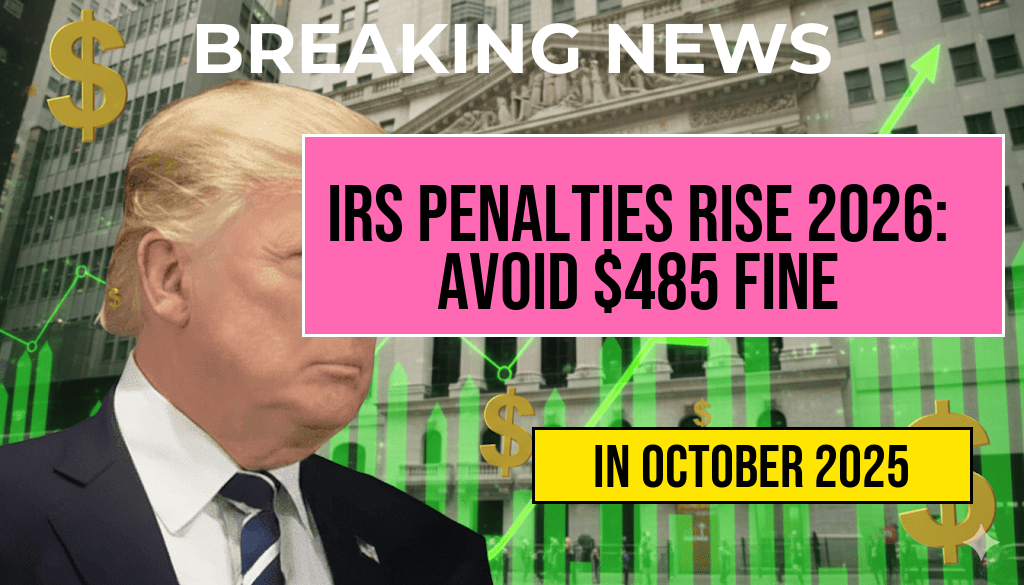IRS Penalties Set to Rise in 2026: Here’s How to Avoid the $485 Late-File Fine
Taxpayers should prepare for significant changes in the IRS penalty structure starting in 2026, as the agency plans to increase late-filing fines and other related penalties. The most notable adjustment involves the late-file penalty, which is poised to rise from its current standard of $435 to approximately $485 per return. This increase underscores the importance of timely filing for individuals and businesses alike. With deadlines approaching each year, understanding the new penalty thresholds and strategies to avoid costly fees becomes critical for taxpayers seeking to maintain compliance and avoid unnecessary expenses.
Understanding the Upcoming Penalty Increase
The IRS periodically updates penalty amounts to reflect inflation and operational costs. The upcoming adjustment in 2026 will see the late-file penalty grow by approximately 11.5%, aligning with annual inflation measures. While the exact figure may vary slightly depending on legislative adjustments, the increase emphasizes the need for proactive tax planning. For context, the current penalty for failing to file a return on time is $435 or 5% of unpaid taxes per month, whichever is less. The new maximum penalty will rise to roughly $485, with a possible cap at 25% of unpaid taxes.
What This Means for Taxpayers
- Increased Financial Risk: Higher penalties mean that delays in filing can result in significantly larger fees, especially for those with substantial tax liabilities.
- Extended Deadlines Don’t Mean Excuses: Filing late remains costly, and taxpayers should plan accordingly to meet IRS deadlines.
- Potential for Penalty Reduction: The IRS offers options to mitigate penalties if taxpayers can demonstrate reasonable cause or enter into installment agreements.
Strategies to Avoid the Late-File Fine
Given the financial implications, taxpayers should prioritize timely filing. Here are some practical steps to minimize penalties:
- File Electronically: Electronic filing is faster and more reliable, reducing the risk of missing deadlines due to postal delays.
- Request Extensions: Taxpayers can request an automatic extension to October 15, but this does not extend the time to pay owed taxes. Payments should be made by the original deadline to avoid interest and penalties.
- Set Reminders: Use calendar alerts or tax software notifications to ensure deadlines are met.
- Seek Professional Assistance: Tax professionals can help navigate complex filings and advise on penalty mitigation options if late submissions are unavoidable.
Additional IRS Penalties on the Rise in 2026
Beyond late-filing penalties, other charges are also set for increases, including:
| Penalty Type | Current Rate | Projected Rate in 2026 | Notes |
|---|---|---|---|
| Late Payment Penalty | 0.5% of unpaid taxes per month | Approximately 0.57% per month | Cap at 25% of unpaid taxes |
| Failure to Pay | Interest rate + 3% | Interest rate + 3.5% | Interest rates fluctuate quarterly |
| Fraud Penalties | 75% of unpaid tax | 75% remains, but enforcement may tighten | Severity varies based on case specifics |
Legal and Financial Implications of Non-Compliance
Failing to meet IRS deadlines can lead to more than just fines. Persistent non-compliance might trigger audits, liens, or even criminal charges in extreme cases. The IRS emphasizes voluntary compliance, but the increased penalty thresholds in 2026 aim to incentivize taxpayers to avoid procrastination. For individuals facing financial hardship, the IRS provides options such as installment plans or penalty abatement requests, which can be essential tools for minimizing penalties while settling tax obligations.
Resources and Additional Information
Taxpayers seeking detailed guidance can consult the IRS official website or reputable financial advisory sources. For a deeper understanding of penalty regulations, refer to the IRS’s official page on penalties and interest at IRS Penalties & Interest. Additionally, for context on inflation adjustments, the Wikipedia entry on US Inflation offers valuable background.
Frequently Asked Questions
What is the reason for the increase in IRS penalties in 2026?
The IRS is increasing penalties in 2026 to encourage timely filing and payment of taxes, aiming to improve compliance and reduce the tax gap.
How much is the late-file fine starting in 2026?
Beginning in 2026, the late-file fine will increase to $485 per missed or late-filed return, up from previous amounts.
Who is affected by the increased IRS penalties?
The increased penalties apply to individual taxpayers, businesses, and tax professionals who file their returns after the deadline or fail to pay taxes on time.
What are some ways to avoid the $485 late-file fine?
To avoid the late-file penalty, taxpayers should file their returns by the deadline, request an extension if necessary, or pay any owed taxes promptly.
Are there any penalties for late payment if the return is filed on time?
Yes, even if the return is filed on time, failing to pay taxes owed can result in penalties and interest charges. It’s important to pay the amount due by the deadline to avoid additional fines.

Leave a Reply